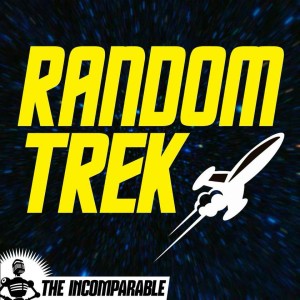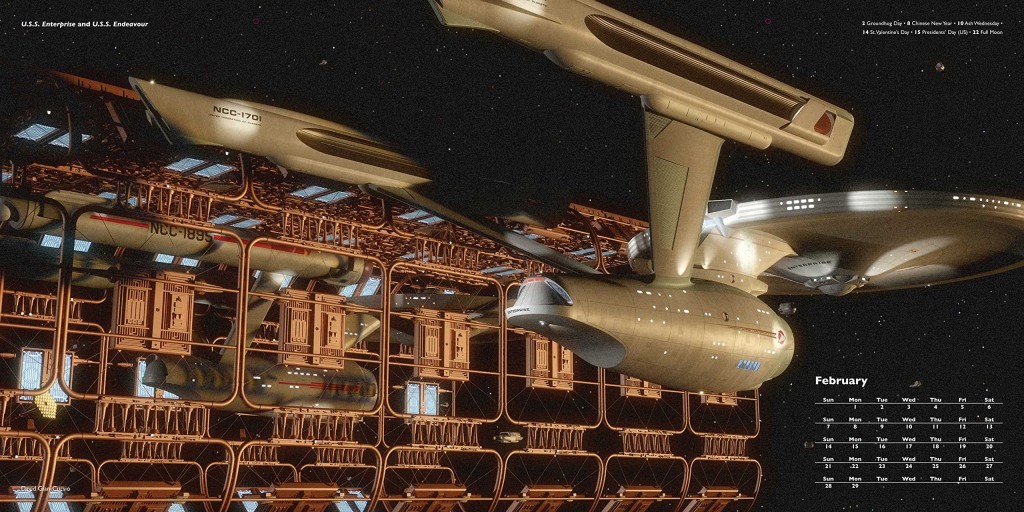Back around Thanksgiving of 2015, I was listening to an episode of the podcast Random Trek, when the host, Scott McNulty, mentioned being a fan of the Ships of the Line art calendars. I tweeted him, mentioning that I’d be in the 2016 edition, and he invited me to appear on the show to coincide with my picture coming up.
The premise of Random Trek, simply put, is that Scott discusses a random episode of Star Trek with a non-random guest. As luck would have it, the random number generator gave us the episode “Time’s Arrow,” the two-part season-finalé/première of The Next Generation’s fifth and sixth seasons. As is Random Trek’s custom, this meant we recorded a double-length episode discussing both parts. And it’s a good thing, too, because we blew past a single episode’s runtime just discussing myself, the calendar, and nerding out on Star Trek in general. And I probably could’ve kept going, but I knew people came to hear about Data meeting Mark Twain, and not my many, many opinions on Star Trek.
To Random Trek listeners who are visiting for the first time, welcome! In the spirt of restraint and being a well-mannered guest, I didn’t pimp myself out too much on the air, but you’re on my website, now! Aside from the Ships of the Line 2016 calendar, some of my other notable works include my on-hiatus project to remake the visual effects of an episode of Babylon 5 (I’ll get back to it eventually), cutscenes for the fan-made Battlestar Galactica flight sim Diaspora, and contributions to various projects with Ninjaneer Studios, including a Ming treasure-ship for the opera The Red Silk Thread and a ruined city for the exhibit Corrosion: The Silent Menace at the Orlando Science Center (featuring TNG alum LeVar Burton).
If you’d like to keep up with me, my Twitter handle is @davidcgc, and I can often be found hanging around Foundation3D, the A.V. Club, and the TrekBBS.
In the spirit of providing added value, here are some notes and links related to things I mentioned on the show.
The best place to find out more background on the Ships of the Line 2016 calendar contest would be these articles on Trek Collective. The first contains an interview with the man behind the magic, Doug Drexler, and the second details all the winning images and the artists behind them.
I appear to have somewhat misused the term “honorarium.” Whoops. Prize. There was a cash prize for the contest. No need to be fancy.
Here is the blog post where I discuss “Comparing Notes” in more detail. Here’s the picture of the Titanic and Olympic I mention. The images I also submitted were “Charting the Crucible” and “Quiet Night at the Office.” If it had been my choice, I would’ve picked “Crucible” to be published, but I’m kind of glad it wasn’t, as it would’ve been the hardest to make a print resolution version of on such short notice, with all the heavily Photoshopped clouds in the background.
If the idea of “Deep Space Nine in the era of the original series by way of the remade Battlestar Galactica” intrigues you, David Mack’s website helpfully lists all the books in the Vanguard book series. You can also check out my model of the Sagittarius, the small scout ship that has a supporting role in that storyline. The novel I mention that includes the tidbit about Endeavour being next on the upgrade list is A Flag Full of Stars, by Brad Ferguson. It’s got a Klingon schoolteacher expat who lives on Earth, and there’s a fun bit with the Space Shuttle. It probably says more about me than the novel that the clearest thing I remember from reading that book in High School was trivia about logistics related to retrofitting imaginary spaceships.
Dennis Bailey is a pretty cool guy (while Memory Alpha doesn’t mention his 3D work, I’m not the first person to use his Enterprise model for SotL, including on the cover of the 2012 edition). One of the episodes he co-wrote, “First Contact” (not the Borg one, the other one) was covered on an earlier episode of Random Trek.
Aside from the diffused lighting of the drydock making Trek ships look better, it also provides interesting visual contrast, since it’s all drab browns and right angles compared to the curving, gleaming-white shape of the ships. Aside from the preponderance of drydock images in previous calendars, I also suspected “Comparing Notes” might be a hit with the judges because they seem to like taking advantage of the format to put different eras of Star Trek design next to each other, which was rarely seen on-screen (at least as far as “hero” ships go).
I love living in the future, especially the future of YouTube. Here are all the William Shatner and Leonard Nimoy introductions to the episodes chosen for the 25th anniversary viewer’s choice marathon.
Seriously, there’s almost an entire Enterprise episode worth of set-up in The Wrath of Khan, and that’s the action-adventure movie, not the take-in-the-experience, contemplative, meaning-of-life movie (incidentally, I love this fan trailer of TMP, advertising it like a modern meaning-of-life sci-fi movie).
Body-swapping joke aside, “Turnabout Intruder” was a terrible, terrible way for Star Trek to go out. The third season was pretty rough, all around.
I stole the argument that The Wrath of Khan rehashes Kirk’s character arc in The Motion Picture from an essay I read in The Best of the Best of Trek, “Indiana Skywalker Meets the Son of Star Trek,” by Kyle Holland (you can find it on Google). I’m not nearly as negative as he was about The Wrath of Khan, though I would rate it as my least favorite of the even-numbered TOS movies, and only a hair behind The Motion Picture, which has a fonder place in my heart than in my rankings (In case you’re wondering, 6,4,1,2,3,5. My rankings of the TNG movies require an excessive amount of white space to demonstrate where one is relative to the next, but suffice it to say First Contact is great, and the others are… less so). I am very hopeful that, after nine movies that were deliberately in TWoK’s shadow, the remakes have finally gotten it out of their system by not just comparing their antagonist to Khan, but literally saying he is Khan, and Star Trek Beyond will give us an opponent who isn’t in that mold.
Kevin Riley appeared in two TOS episodes, and honestly wasn’t that bad. TOS had a strong cast, as we point out.
The Incomparable episode on The Motion Picture and The Final Frontier, “Hole Farmers,” has since been released, as has the episode on Insurrection and Nemesis, “I Have an Appointment With the Tholian Ambassador.”
John Eaves (not “Jonathan,” sorry, I must’ve misspoke because I had just mentioned Jonathan Frakes) designed the Enterprise-E, along with many, many other ships and objects in Star Trek. The Trek-veteran “set artist”* on Nemesis whose name I nearly mentioned was Herman Zimmerman, but I caught myself because I think I was afraid I was going to say Andrew Probert, and wasn’t confident at that moment I was going to refer to the correct person.
*I swear, I have formal training in filmmaking. “Production designer.”
The Generations writers’ commentary on the DVD has a pretty interesting discussion between Ron Moore and Brannon Braga about how they wanted to kill off Kirk in a way that wasn’t how the audience would expect a hero to go out. I’m glad they decided being shot in the back after gloating that “the 24th century isn’t so tough” was a bit too unexpected.
The Motion Picture also has Kirk do a little finger-raise as a comedic gesture in a tense moment. Perhaps some Shatnerologist out there can see if that’s a trick he deploys often.
Kirk met, and told off, the greek god Apollo in “Who Mourns For Adonais?”
“Allegiance” is the episode where Picard is replaced by a fun-loving duplicate who slathers everyone in positive reinforcement, which the crew regards with suspicion and anger. Well, the main cast does. The below-deck crew seems to love the attention. Luckily, Picard mellowed out, to the point where I can imagine later movie-era Picard telling Geordi he’d done a good job and maybe, just once, buying a round for everyone in Ten Forward and having a sing-along.
The excellent Voyager episodes that never happened (or happened in the distant future or to a duplicate crew) I mention are, in order, “Living Witness,” “Year of Hell,” and “Course: Oblivion.” To be fair, some of the best TNG, DS9, and ENT episodes also unhappened in the end. I have a feeling it happened more than once, but the specific recurring antagonist I mention that didn’t actually end up recurring was the Vaadwaur in “Dragon’s Teeth.”
The Voyager relaunch novel series in its current form starts with Full Circle, by Kirsten Beyer. I was being a bit unfair when I compared it to the old Star Wars EU, it’s not really that imposing for a new reader (from what I hear from new readers). While the novel continuity has become a bit expansive in the last decade-and-a-half, it’s all still Star Trek, and there probably isn’t anything that’ll confuse you too much if you just pull whatever random book off the shelf that strikes your fancy (they haven’t even gotten to when Romulus is destroyed and Spock goes missing yet, and that’ll probably really shake things up). Still, if you want some degree of background before jumping in, David Mack’s Destiny trilogy is the most momentous work in setting the status-quo of the TNG-era novelverse, and is also an epic tale pitting the ideals of Star Trek’s optimistic future against existential peril and terrible loss. Granted, it’s space opera, so the fate of the universe is imperiled surprisingly often in Star Trek, but I think this one treats it with the most gravity.
O’Brien is killed and replaced by his future self in “Visionary.” “O’Brien must suffer” was practically a sub-genre of DS9 episode, so I won’t list other examples here.
Data was built by the scientist Dr. Noonian Soong, who apparently believed in durability and high-quality construction.
For our younger listeners, “jumper switches” were a thing we had to deal with in the bad old days of computing.
It seems both “card sharp” and “card shark” are acceptable.
The old 49er may have been code-switching, or perhaps it was just a more formal time.
Harlan Ellison’s beef with the producers of Star Trek over their rewrites to “The City on the Edge of Forever” is too complex to go into here, but the Memory Alpha article does describe some of the more notable changes.
I learned about the pan-and-scan trick for putting camera moves in composite shots in TNG from this article on Ex Astris Scientia.
The transporter-centric TNG episode I mention is “Realm of Fear.”
It slipped my mind, but there were actually two sets of blueprints commissioned for the Enterprise-D, by Ed Whiteface and Rick Sternbach, though only the latter was officially published. Sternbach made a revised version of his blueprints a few years ago as part of a cancelled Japanese subscription collectable model. The new blueprints themselves may or may not be released on their own in the future.
The episode where Deanna argues with the replicator when it tries to make her a healthier version of a chocolate sundae rather than something that tastes good is “The Price.”
Chekov wondering about whether Kirk’s glasses were infinitely old was in “The First Thing We Do…”, part one of The Trial of James T. Kirk by Peter David.
I had a lot of fun guesting on the show. Thanks again to Scott McNulty for inviting me, and I’ll see you all around the internet!


